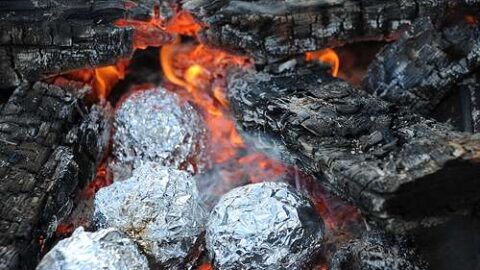"Whatever the origins of bonfire night, its central features can still be thought of as good for the soul. Staring into the heart of a massive outdoor fire, and then at a series of man-made shooting stars, is not a bad way to get one wondering about one's place in the universe. Or at least to work up an appetite." Hugh Fearnley-Whittingstall

It's a really cold day - doesn't it seem colder this year than others? So when I turned to my next first recipe choice and found it was all about Bonfire night It made me feel nostalgic for the bonfires of my youth on November 5th, when every year we would build a bonfire in the backyard, make a guy out of old clothes stuffed with something - paper?, set off a few fireworks like catherine wheels and rockets - didn't like 'bangers', hold a few sparklers and eat potatoes cooked in the fire.

Our potatoes always looked like this - charcoal on the outside and fluffy in the middle. Even if we wrapped them in foil they still got charred. Besides they didn't taste the same if they were perfectly cooked with no charcoal. We could have those any day for dinner. These were different and therefore special, even if, if I'm honest, charcoal does not have a really good taste.
And here in Australia it's the wrong time of year anyway. No let me rephrase that. It's not the right month, so not the right date, so no real reason to have a bonfire party. Indeed in the right month it is just not possible - it's dangerous and lighting fires outside is banned. These days November 5th for me is my younger son's wedding anniversary with its memories of a beautiful picnic in the park after the wedding on a gorgeous almost summer day. Hardly Guy Fawkes - or even Halloween or All Saints, Martinmas, or Samhain either - all festivities associated with beating back the coming dark with fire. We've just got to think of some reason to celebrate something in Winter or Autumn so that we can have another public holiday and a bonfire.
"These things we do on the brink of winter fill a very human need, as the clocks go back and the chill sets in, to huddle together and hold off the coming darkness just a little longer." Gaby Hinscliff - The Guardian

But up there in Yorkshire it's big, because - something I did not know - Guy Fawkes was a Yorkshireman - from York, although his old school, St. Peter's in York does not partake in the bonfire night celebrations because "they don't burn effigies of past pupils." So very English.
It is fitting therefore that in my first recipe book this time - Theodora Fitzgibbon's next book - A Taste of Yorkshire in Food and Pictures, the first page is dedicated to two Guy Fawkes night foods - parkin and plot toffee. She does also mention the baked potatoes, but you don't need a recipe for them do you? As I said, nowadays we wrap them in foil. Back then they would just have been put in the fire.

So parkin. I was dimly aware of parkin, but now that I think about it maybe because it's also a surname - a Yorkshire one I think. Parkin the food is a sticky kind of ginger cake made with oats and treacle. Nobody seems to know why it's called parkin, or indeed what parkin means.
"The modern name parkin, or perkin, possibly related to a diminutive of the name Piers, is “inexplicable but may denote affectionate disdain”. Laura Martin and Catherine Brown - Taste of Britain
I think they have found references of parkin back in medieval times, but nobody is really quite sure where it comes from. There was an earlier version called thar cake, which according to Wikipedia:
"is of ancient Teutonic origin, as tharf or theorf meant unleavened, un-fermented, solid tough or sodden in Old English"
It is also thought that these early versions were flatter and more biscuit like as they would have been cooked on a griddle over the hearth rather than in an oven. I think Felicity Cloake in her article on how to make the perfect parkin refers to this kind of variant. The essential ingredients are oats, treacle and ginger because it's a kind of gingerbread. And it is made in November because this was when the oats, which were a local crop, were harvested. Originally, of course, there was no association with Guy Fawkes but there were all those other ancient late Autumn bonfire festivals. The Gunpowder plot and the plotters' subsequent executions would have been a useful, more modern reason for the bonfire. Although I don't think the plotters were burnt. I don't like to think about that aspect of it really. Far too gruesome and barbaric. But then bonfires are primitive, a more polite word than barbaric but sort of meaning the same.
Here is the recipe that Theodora Fitzgibbon gives us, which she says is a "good spicy, sticky cake", and I have to say that all the photos I saw did look tempting. The one below is Felicity Cloake's.

YORKSHIRE PARKIN
225g fine oatmeal, 1 tsp baking powder or baking soda, 3 tsps ground ginger, 225g flour, 225g brown sugar, 225g dark treacle, 112g butter, margarine or butter and lard mixed, 1 large egg, 1 cup (250ml) milk, approximately.
Sieve the flour, baking powder and ginger together, then add the oatmeal. Put the treacle, butter and sugar into a saucepan and melt slowly. Beat the egg with the milk. Then add the treacle mixture to the flour and beat well, and finally add the egg and milk. Mix throughly and pour into a large rectangular tin (25cm x 15cm x 8xm that has been lined with greaseproof paper and well greased. The mixture should be very soft before cooking in a moderate oven (170ºC) for half an hour, then at 150ºC for a further half an hour, but test with a skewer in the centre before taking out. This is best made a few days before eating.
Indeed that last remark is repeated in almost all the recipes I found because:
"No matter how tempting it may be, do not eat the parkin on the day you have made it. It needs to be kept in an airtight box or tin for at least three days. The cake needs a bit of time for the flavours and stickiness to develop." British Food: a History
I gather when it is first cooked it is harder and drier. So best to keep it to let it go sticky. It should be sticky. Felicity Cloake will also take you through all the other arguments about what kind of oats, treacle and/or golden syrup, butter and/or lard, what kind of flour, etc. etc.

And if you want to try a more modern, 'gourmet' version you could try the one from James Martin, who serves his with a sticky sauce and cream. Looks like a very yummy sticky date pudding.
What really interests me about this though, is that it does not seem to be eaten in the south of England at all. It is so localised - well there is a Lancashire version, but that's just across the hills. Down south we know not of it. You would think that if it was so good it would have travelled south - like Yorkshire pudding. Interesting that in such modern times when, in normal circumstances, travel is so easy, something can be so parochial.
But speaking of sticky the other Yorkshire Guy Fawkes thing is toffee - specifically something called Plot toffee or Bonfire toffee or Tom Trot (I have no idea where that name comes from).
It's one of those solid kinds of toffee. Not really what we think of as toffee which is generally chewy. You suck this. I don't think we ever made this toffee when I was a child but we did make Everton toffee (Lancashire), which is paler in colour. For this toffee, like the parkin, is made with treacle. I think most of the recipes I saw like this Bonfire night treacle toffee from The Spruce Eats, just left the toffee to set in the tray into which it was poured, but the one in Theodora Fitzgibbon's book, from the Women's Institute in Mansfield, says you should pull it. I remember doing this with a toffee we made once. It was such fun. When the toffee was still soft, but cool enough to handle you made it into a sort of rope and then pulled it out, twisted it, folded it, pulled it until it changed colour. Then you snipped it with scissors into bits which were then left to cool and go hard.

So here is Theodora Fitzgibbon's recipe:
PLOT TOFFEE
Put 225g dark brown sugar in a saucepan with 225g black treacle and 112g butter, then let the sugar dissolve slowly, and simmer for half an hour without stirring. Drop a little into cold water and if it crackles, then it is ready. Pour on to a greased dish and work with the hands, pulling into long lengths and twisting until the toffee is bright and clear. Break into pieces when cold.
Down south we also do not traditionally eat toffee on Guy Fawkes Day. Toffee apples however, seem to be a thing if you are to believe the various articles I found.

Maybe it's because they look a little bit like bombs. I don't remember toffee apples on Guy Fawkes night, but I could be wrong there, and they're not specifically a bonfire night thing either. To me they are more a thing that you bought at fairs. And a bit overrated I thought. The toffee was nice but the apples often weren't. You should choose your apples carefully I believe. And the toffee is not toffee - it really is just boiled sugar:
"in the context of the toffee apple "the word 'toffee' means simple boiled sugar, not the mixture of sugar and dairy produce which is what the word usually refers to." Alan Davidson
It seems that over there in England the bonfire night traditions are being expanded. Down south in Lewes bonfire night is huge. I think that probably comes more from the warning bonfires that used to be lit on the tops of the hills across the Downs, but there are societies and parades, and bonfires. I don't know what they eat.
The chefs of modern England are there with suggestions though - Nigel Slater goes for a warming sausage stew, or why not try Toffee hotdogs with tomato and apple sauce from a Guardian reader (voted most popular suggestion) or for something really out there Dynamite doughnuts from Liam Charles.
There won't be a bonfire here. It's too cold to venture outside, but we will be sitting in front of an open fire tonight. No Guy Fawkes though. I did like this final quote about fireworks and Guy Fawkes:
"we can celebrate a man’s failure to blow something up by blowing some things up." Tamal Ray - The Guardian












Comments